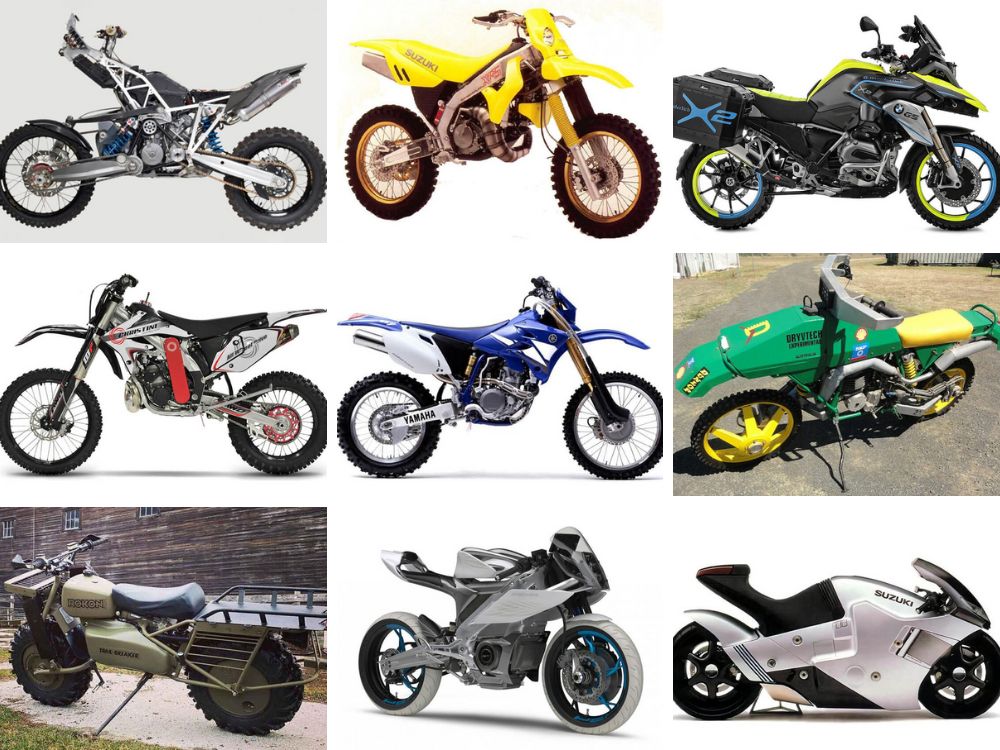Table of Content
Several attempts have been made to revolutionize the motorcycle industry by introducing unique concepts and changes. One of the most notable changes introduced in motorcycles was the two-wheel drive. However, certain limitations prevented this idea from working at first, including no market exists for this type of vehicle and a lack of advertisement by manufacturers. The two-wheel drive motorcycles drew inspiration from ATVs and four-wheel drive (4WD) jeeps. These vehicles are popular due to being able to maneuver on difficult terrain. The intent of two-wheel drive motorcycles was to create dirt bikes capable of off-roading with better traction and efficiency. Read this article to learn about the top 10 two-wheel drive motorcycles.
1. What are Two-Wheel Drive Motorcycles?
In two-wheel drive motorcycles, the front and rear wheels are connected to the transmission shaft via gears and chains that transmit the engine power. There is also a switch installed on these motorcycles to turn the front-wheel drive on and off.
2. Top 10 Two-Wheel Drive Motorcycles
2.1 KTM 2WD Prototype

KTM was the first to develop a hydraulic-powered two-wheel drive motorcycle prototype, opening the doors for several innovative ideas on how to develop versatile 2WD motorcycles. Later, KTM also developed an electric-powered front-wheel drive motorcycle that inspired Wunderlich and BMW to develop the Wunderlich Hybrid BMW R1200GS. To power the front wheel, the KTM 2WD Prototype included a hydraulic motor connected to the front wheel. The motorcycle received power from the hydraulic pump connected to the sprocket via a chain. Unlike shaft two-wheel drive motorcycles, the KTM 2WD prototype eliminated the need for additional complex mechanisms, including gears, chains, and shafts. The hydraulic-powered front-wheel drive only delivered power when the rear tire slipped or lost traction.
2.2 Suzuki XF5

Suzuki was the first company to start working on the two-wheel drive motorcycles concept in the late 1980s. In 1991, Suzuki presented three AWD concept bike designs. However, only the AWD Suzuki XF5 Enduro made an impact with its revolutionary transmission design and 200 cc two-stroke engine. This motorcycle’s design became well-known and was later adopted by several motorcycle companies to develop AWD motorcycles.
Unlike the Wunderlich Hybrid BMW R1200GS’s electric-powered front-wheel drive, the Suzuki XF5’s front wheel was connected to the same engine sprocket that transferred power to the rear wheel via a series of chains.
The front-wheel drive system is a complex piece of machinery, but it works the same as the rear-wheel drive. The transfer box installed above the engine is connected to the sprocket through a chain, and the power transfers to the headstock installed in the steering head. The Suzuki XF5’s front forks were unconventionally designed towards its right leg, acting as a front suspension. Meanwhile, the left leg had an output shaft that carried power from the engine to move the front wheel. Though the front-wheel drive mechanism installed on the Suzuki XF5 was a complex system, it only added 17.2 lbs to the motorcycle’s total weight.
2.3 Wunderlich Hybrid BMW R1200GS

Wunderlich is an innovative company dedicated to producing BMW parts and accessories for over 35 years. It worked with an Italian company, Evolt, and BMW to create the 2WD Wunderlich Hybrid BMW R 1200 GS. The Wunderlich Hybrid BMW R 1200 GS drew inspiration from the 2WD KTM hybrid electric motorcycle and used the BMW R 1200 GS as a model base. It differed from conventional 2WD motorcycles due to the front wheel not being powered by the engine. Instead, it was powered by a 10 KW electric motor fitted toward the front end. The front-wheel drive could be turned on and off to assist in maneuvering if the rear wheel became stuck and could not provide adequate traction. The front-wheel drive also assisted when parking the motorcycle on a slope or reversing.
The only problem with the two-wheel drive motorcycle was synchronizing the power and torque delivered by the front and rear wheels. Luckily, this was resolved by installing modern micro-computers to regulate the power output.
2.4 Christini

Christini Technologies, a U.S. company has been building all-wheel drive motorcycles, especially AWD dirt bikes, for years. The AWD Christini was first tested in 2002 and has received several upgrades over the years.
The AWD Christini used gears and chains to deliver power to the front wheel like the Suzuki XF5. Christini Technologies also designed AWD conversion kits for other models. The AWD Christini was designed to provide better traction and higher power output for better maneuverability and performance.
The front-wheel drive can be turned on and off if the rear wheel loses traction. Despite being fitted with additional parts, the AWD Christini weighed only 278 lbs thanks to its lightweight aluminum twin-spar chassis.
2.5 Yamaha 2-Trac

The Yamaha 2-Trac is the only AWD motorcycle that made it to production. However, it was produced in limited numbers. The Yamaha 2-Trac utilizes a unique mechanism developed in collaboration with the Öhlins to transfer power to the front wheel. The front-wheel drive mechanism drew inspiration from the KTM two-wheel drive system prototype. The Yamaha 2-Trac was fitted with a gas-pressurized hydraulic accumulator to power the front wheel. The accumulator includes an automatic switch that activates the front-wheel drive whenever the rear wheel loses traction. For better off-road performance, it is also equipped with Öhlins suspensions. Despite being built in limited numbers and designed for track racing, the Yamaha 2-Trac’s innovative design has room for further improvement.
2.6 Rokon

The Rokon is the second oldest 2WD motorcycle and it has been around for almost six decades. the front suspension assembly was not installed initially to make room for the installation of the front-wheel drive mechanism. Fat balloon tires were used for damping and to ensure comfortable rides. Later, suspensions were installed to ensure an ideal off-road performance. The Rokon drew inspiration from the Land Rover. This motorcycle utilizes all three standard drive systems, including chain, belt, and shaft which makes it different from other motorcycles.
2.7 Drysdale 2x2x2

In the 1990s, Ian Drysdale, an Australian engineer, developed a uniquely-designed 2WD motorcycle for the military. It was different from other motorcycles due to being hand-made and it has several distinguished features. This motorcycle does not include standard drive systems, including shaft, belt, and chain. Instead, both wheels were driven by hydraulic systems, including hydraulic pumps and motors. The speed of the motorcycle is controlled by varying the amount of oil delivered to the motor. The hydraulic motors are powered by the oil pressure generated by the hydraulic pumps.
The most distinguished feature of the Drysdale 2x2x2 which makes it unique from other motorcycles is its steering wheel. The steering wheel has no physical connection to the wheels and front forks. This motorcycle was steered with the help of the hydraulic system. The master steering cylinder installed under the steering wheel was connected to the cylinders in the hubs of the front and rear wheels. As the rider moved the steering wheel, the steering cylinder’s piston became displaced, which changed the oil pressure throughout the hose and exerted pressure on the cylinders in the hubs, changing their angles of rotation.
The one major drawback of the Drysdale 2x2x2’s steering system was that you can only turn the tires when the engine was turned on and hydraulic pressure was active in the system. The Drysdale 2x2x2’s braking system also included a hydraulic pump. When the rider pressed the brake pedal, it caused the oil pressure in the system to change, effectively slowing down the motorcycle.
2.8 Suzuki Nuda

The Suzuki Nuda was one of the most innovative and stylishly-designed two-wheel drive concept sports bikes. This concept bike is worth mentioning because it had a revolutionary feature to power the front and rear wheels. Like most conventional motorcycle designs, the Suzuki Nuda’s rear wheel was connected to the shaft drive to deliver power from the engine. Meanwhile, another shaft drive was installed to connect the front wheel to the engine. To power the front wheel, the Suzuki Nuda did not use any joints or secondary sprockets.
The Suzuki Nuda also features a four-stroke, four-cylinder DOHC engine capable of a torque of 88.13 Nm at 11,200 rpm and a horsepower of 148 hp at 12,800 rpm. Despite its bulky look, the carbon fiber frame ensured a low overall weight. The Suzuki Nuda was also fitted with an adjustable front suspension and a magnetic key system.
Also Read: TOP 10 FASTEST MOTORCYCLES IN THE WORLD 2022
2.9 Yamaha PES2

The Yamaha PES2 is an electric concept sports bike with a futuristic design. It has a monocoque chassis that keeps the body, frame, and parts close, ensuring a low overall weight of 286 lbs. A lithium-ion battery is housed in the center of the bodywork that powers the brushless DC motorcycle. The front and rear wheels are driven by electric motors and the torque is synchronized using engine maps. The front motor is designed to produce electricity when the brakes are applied.
The Yamaha PES2 became hyped since the day of its introduction. However, Yamaha has been unsuccessful in mass-producing this motorcycle despite being announced in the 2004 annual report.
2.10 Ural Sidecar Outfit

Ural was the first motorcycle manufacturer to build a two-wheel drive motorcycle with a sidecar. The Ural sidecars were initially manufactured for the Russian military and are currently being made for civilians as well. Technically, it is not an all-wheel drive motorcycle since the third wheel on the sidecar is not powered by the engine. However, the Ural sidecar outfit is the first 2WD vehicle still in production and has encouraged other motorcycle manufacturers to focus on creating AWD motorcycles.
Also Read: SEVEN BEST DIESEL MOTORCYCLES OF ALL TIME
3. Final Words
The 2WD motorcycles failed to become mainstream, despite being a popular concept. The 2WD concept can be advantageous in motorcycles, particularly dirt bikes. A front-wheel drive system, along with rear-wheel drive can help dirt bikes to improve their off-roading capabilities by ensuring better traction.
The two-wheel drive system is not as simple as it sounds. It makes it difficult to ensure harmonized power and torque delivery to both the front and rear wheels. However, as technology has advanced, the smart computer and engine mapping system has made it possible to match the rotation of both the front and rear wheels to ensure ideal traction and stability. Technology has made it possible for motorbike manufacturers to produce reliable and good-quality 2WD motorcycles.
You can customize your rear-wheel drive motorcycle to improve its performance and comfort on long-distance rides by installing a crash bar, fairing, windshield, sissy bar, and backrest. You can also choose from several luggage options, including saddlebags, tank bags, handlebar bags, backpacks, and motorcycle trunk bags available at Viking Bag’s online store to improve the storage capacity of your motorcycle.













Leave a comment
All comments are moderated before being published.
This site is protected by hCaptcha and the hCaptcha Privacy Policy and Terms of Service apply.